Definition: Employee empowerment is the process of facilitating employees with specific authority and responsibility to achieve the organisational vision by exercising their talent, skills and creativity. It was initially being related to forming of trade unions, but it is much more than that. It enables the managers to convert the regular workforce into a high potential resource for the organisation’s growth and success.
Example: JetBlue Airlines is a perfect example of employee empowerment. The company allows the airline staff to make their own decisions as far as it does not violate the company’s policies and serve the values of safety, integrity, care, fun and passion. This provides a different and valuable experience to its customers.
Content: Employee Empowerment
Pre-requisites of Employee Empowerment
To ensure the active empowerment of employees, the top management needs to analyse multiple aspects related to the organisation and the employees.
These pre-requisites for empowering employees are discussed below:
- Management’s Trust and Support: The management must have faith in subordinates and support their ideas and initiatives.
- Open Communication: There should be no communication gap in the organisation and subordinates should feel free to express their views.
- Employee Engagement: The workforce must be highly motivated and engaged in achieving organisational goals and objectives.
- Decision-Making Ability: The employees must possess the skills of making the right decisions at the right time.
- Group Reward System: The organisation should be able to recognise and reward team performance and achievement.
- Error Tolerance and Rectification: The organisation must have a system where employees are allowed to make mistakes and learn from those mistakes.
- 360 Degree Feedback Method: An overall feedback system must be followed in the organisation where the employee’s performance should be analysed by the managers, supervisors, team, colleagues, subordinates as well as employee himself.
Process of Employee Empowerment
Employee empowerment is a long-term process which emphasises the overall transformation of the organisation’s values, culture and decision-making model.
All this cannot be achieved in a day, and its impact can be seen over the years of bringing it into practice.
The steps involved in initiating employee empowerment in the organisation are explained as follows: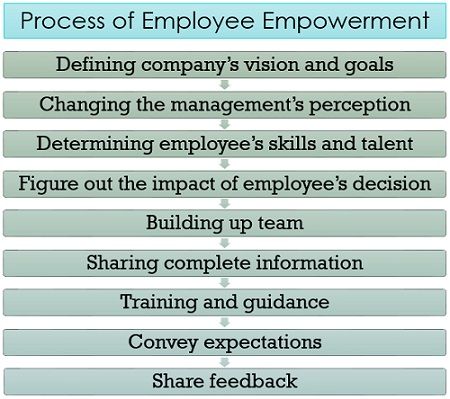
Defining the company’s vision and goals: The managers have to make the employees familiar with the company’s long-term vision and short-term goals to reach that vision.
Changing the management’s perception: It is essential to transform the management’s believes and thought process regarding employee empowerment.
Determining employee’s skills and talent: To find out about the skills and competency of the employees is the next step for employee empowerment.
Figure out the impact of employee’s decision: It is necessary to presume the effect of the future business decisions that will be taken by the employee after getting the authority. It is also essential to evaluate the harm it may cause to the organisation.
Building up a team: The managers form a group of employees with the desired skills and talent required to perform a particular task.
Sharing complete information: The managers need to share with the employees the in-depth information related to the organisation and the task to be performed by them.
Training and guidance: Proper training and supervision are to be given to employees to perform a specific task and take decisions wisely.
Convey expectations: The managers, instead of enforcing their aspirations, should convey the same to the employees so that they are clear about what they need to achieve.
Share feedback: The last step is to give feedback on the employee’s performance in an encouraging manner so that they get charged up to perform even better.
Theoretical Approaches to Employee Empowerment
Employee empowerment is a process of bringing some change either in the organisation or the perception and attitude of employees towards their work and the organisation.
To understand more about the two critical approaches in this context, read further: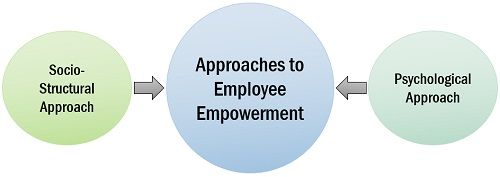
- Socio-Structural Approach: The transformation of organisational structure, policies and practices can be an effective means to bring in employee empowerment in the organisation.
- Psychological Approach: The psychological approach refers to changing the perception of the employees about their work and the organisation. It aims at the self-motivation of employees to achieve organisational goals by giving them the authority of self-control and decision making.
Ways of Employee Empowerment
There can be various means through which any organisation can succeed in the long run. It is all about valuing the participation of employees to achieve organisational goals. Some of the ways of employee empowerment are discussed below: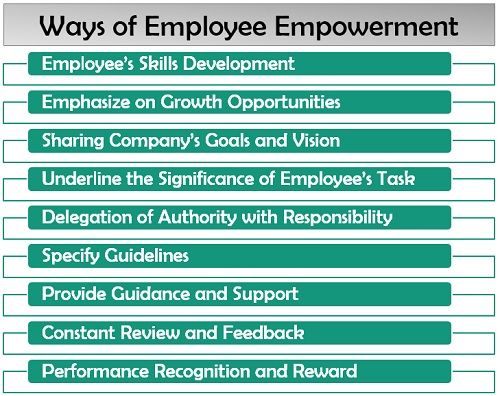
Employee’s Skills Development: The management should take steps to develop the required skills in employees through training.
Develop Growth Opportunities: The management should focus on the growth opportunities within the organisation to motivate and empower employees.
Sharing Company’s Goals and Vision: Making the employees familiar with the long-term vision and goals of the organisation develop their trust in the organisation.
Underline the Significance of Employee’s Task: The management should make the employees aware of what they are doing and why they are doing so. This way, the employee perceives the importance of his task for the overall project and the organisation.
Delegation of Authority with Responsibility: Handing over the responsibility to fulfil a given task in the desired manner is not enough. The employee must be given authority to take task-related decisions independently.
Specify Guidelines: The management should give the liberty to employees to perform a task in their way but also create boundaries by declaring guidelines beyond which they cannot function.
Provide Guidance and Support: The management should allow the employees to be creative and work independently, providing guidance and support. This boosts employee morale and helps them to overcome task-related problems.
Constant Review and Feedback: With the means of constant review of employee’s task and giving feedback (positive or negative) from time to time, the potential of employees can be increased.
Performance Recognition and Reward: One of the methods to empower employees is to recognise their performance and reward them for their achievements.
Benefits of Employee Empowerment to the Organisation
Empowered employees are the highly motivated, committed and self-disciplined workforce. It also reduces the workload of top management.
Following are the multiple other benefits of employee empowerment in an organisation: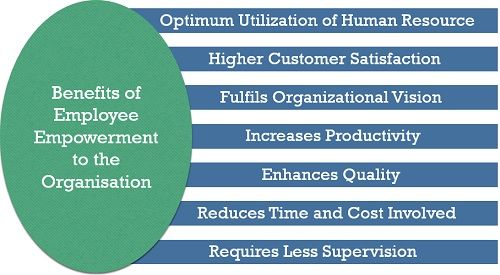
- Optimum Utilization of Human Resource: Employee empowerment leads to the motivation of employees, and they tend to perform better by themselves. Thus, the organisation can make the best use of its human resource.
- Higher Customer Satisfaction: The employees value the organisation and give their best to fulfil the customer’s needs.
- Fulfils Organizational Vision: Employees get a clear idea of the organisation’s vision, and they streamline their activities accordingly.
- Increases Productivity: When employees are allowed to give suggestions, share problems and ask questions related to work; new ideas and techniques are developed to augment the process and increase productivity.
- Enhances Quality: Empowered employees are more focussed and involved with the business process; this improves the overall quality of the business activities.
- Reduces Time and Cost Involved: The time to take action have reduced since employees have the authority of making their own decisions independent of their supervisors. Due to employee’s genuine involvement in the process and efforts to improve the same, the cost of production has reduced.
- Requires Less Supervision: A self-disciplined and self-controlled team doesn’t need much supervision.
Benefits of Employee Empowerment to the Employees
Employee empowerment is not only beneficial to the organisation but also proved to be a turning point in the performance and perception of the employees.
Following benefits of employee empowerment to the employees justify this statement: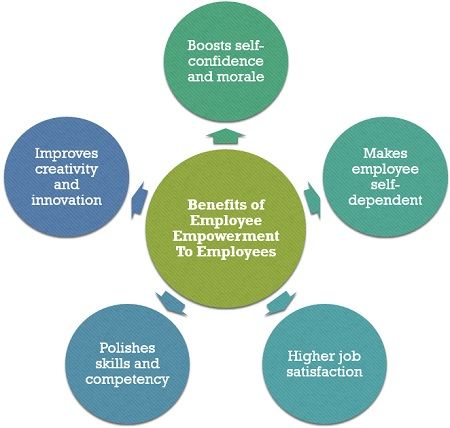
- Boosts Self-Confidence and Morale: The employees develop trust and a sense of belongingness towards the organisation, making them more confident and happy.
- Makes Employee Self-Dependent: The employees become self-reliant and develops a habit of taking decisions on their own, which ultimately reduces their dependency on others.
- Higher Job Satisfaction: The employees feel valued and consider themselves essential to the organisation; this increases the level of job satisfaction in them.
- Polishes Skills and Competency: In the process of employee empowerment, the employees get a chance to learn new skills and become more competent in their work.
- Improves Creativity and Innovation: When employees are empowered, they are free to think their way, they can explore their creative and innovative side.
Drawbacks of Employee Empowerment
Though, employee empowerment can bring a great deal of success to the organisation, if not correctly implemented, it can prove to be disastrous for the organisation.
Discussed below are some of the challenges coming forth in the way of top management, when they opt for employee empowerment: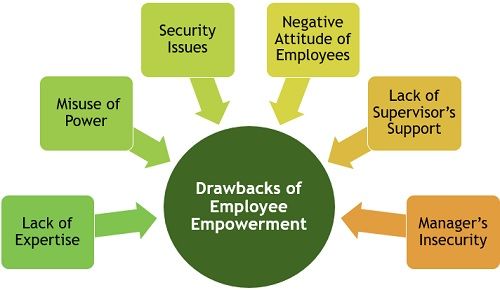
- Lack of Expertise: The employees either lack specific skills and expertise to execute the given task, or they are unwilling to learn such skills. This may lead to project failures.
- Misuse of Power: Authority of decision making in the hands of employees may be misused by them for satisfying their interest.
- Security Issues: Employee empowerment demands to share crucial organisational information and data with employees. Such data can be leaked or misused by the employees leading to security issues.
- Negative Attitude of Employees: Employees sometimes have a negative attitude towards the managers and the organisation and may not contribute wholeheartedly to such initiatives.
- Lack of Supervisor’s Support: Out of jealousy or feeling of superiority, the supervisors may not provide complete guidance and support to ensure the empowerment of their subordinates.
- Manager’s Insecurity: Managers tend to misunderstand employee empowerment, as they feel that it may harm their position. This insecurity restricts them to participate in the process genuinely.
Conclusion
An empowered employee gain confidence and trust in the organisation. He/she becomes more loyal and dedicated towards his job, thus leading to his long-term association with the organisation and maintaining cordial relations with the management.
Leave a Reply